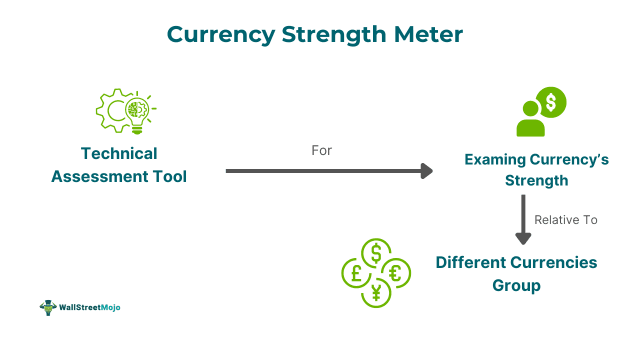Table of Contents
What Is Currency Strength Meter?
Currency strength meter (CS indicator or CSM) is a technical metric that calculates the contrasting strength of various currencies for trading platforms like Meta Trader 4 (MT4) or Meta Trader 5 (MT5). It aids traders in identifying weak and strong currencies, helping them make beneficial trading decisions by forecasting potential trading avenues and currency movements.

It offers a visual presentation of the performance of different currencies against a group of foreign currencies. Hence, it helps forex traders compare the currencies' weaknesses and strengths. Thus, traders can easily identify the weak and strong currencies, leading to well-judged investments in trading.
Key Takeaways
- Currency strength meter (CS indicator) is a technical statistic used to determine the relative strength of different currencies on trading platforms such as MT4 or MT5.
- It helps traders discover strong and weak currencies and helps them make profitable trading decisions by using it to predict possible trading channels and currency fluctuations.
- Its formula = (% Price Change in Currency) / (Average % Price Change in All Currencies)
- It offers a real-time evaluation of a currency's strength by deploying a live exchange rate, but if coded poorly, meters might freeze, lose memory, and read incorrect signals.
How Does Currency Strength Meter Work?
A currency strength meter (CSM) is a technical assessment tool used in forex trading that examines the relative strength of various currencies pitted against one another. It pictorially represents the manner in which currencies operate in relation to a collection of other foreign currencies. As a result, it facilitates the identification of the currency that is strong or weak at any particular time point for traders.
CSM functions by determining the percentage alteration in a currency's trading price over a selected timeframe and contrasting it against the average percentage fluctuation of all listed currencies in a bouquet of currencies. Such an algorithmic working gives a snapshot of a currency's performance, providing traders with the ability to make wise and informed trading decisions based on existent market conditions.
It has a lot of implications, and that is too broad and impactful. The meter of currency strength plays a significant role in identifying weaker and stronger currencies for traders. As such, it leads traders to correction pairings of currencies for making potential gains. Therefore, if a trader trades a weak currency against a strong currency, it enhances the chances of profitable trade manifolds. It happens because such pairs are highly likely to represent preferable price movement.
Traders have often used CSM to confirm signals from different technical indicators and ascertain potential trading avenues. One can also enhance their trading strategy by obtaining in-depth details regarding market trends from the CSM. Consequently, traders can use these signals to avoid pairs moving away from each other in opposite directions, leading to minimal risks in their trading.
Further, it has greatly influenced the financial world by helping traders navigate the complexities of the forex market. Plus, it can provide real-time data about currency weakness or strength to trades, helping them make timely decisions.
Examples
Let us use a few examples to understand the topic.
Example #1
The CSM formula = (% Price Change in Currency) / (Average % Price Change in All Currencies)
Where:
- Currency Strength = the currency strength relative to other currencies.
- % Price Change in Currency = currency’s percentage price change during the designated period.
- Average % Price Change in All Currencies = all currency's average percentage prices change during the same designated time.
Using the above formula, we can calculate CSM for Sarah, a trader of Old York City, using a currency strength meter daily for currency strength analysis.
She obtained the following data from the currency strength meter live:
- Price change of US dollar relative to other currencies= 2%
- The average change in the price of other currencies = 1%
- Hence CSM found by = 2%/1% =2
This means that at this moment, the USD was twice as strong as the EUR as per currency strength meter forex.
Example #2
Let us assume that a trader, Johnny of Old York, wants to make good profits in forex trading. He tries to use the CSM for his trading strategy while choosing a one-hour frame starting at 10 AM. At this moment, he sees that the US dollar is very strong and the Euro has weakened. Suddenly, news flashes on television regarding economic changes in the United States government. Hence, Johnny decides to use the new RSI indicator.
As a result, the meter doubly confirms the strength of the USD and the weakness of the Euro, motivating Johnny to look out for any potential signals of USD /EUR trading. Meanwhile, he successfully determined a potential buying signal concerning USD /EUR that he cross-verified from his moving average. After confirmation, Johnny enters into the buying position with the objective of capitalizing on the estimated strength of the US dollar against the weak EUR.
Advantages And Disadvantages
Let us use the table below to understand its pros and cons:
| Advantages | Disadvantages |
|---|---|
| It offers a real-time evaluation of a currency's strength, deploying live exchange rates. | If coded poorly, then meters might freeze, lose memory and read incorrect signals. |
| Identifies weak and strong currencies for making gainful trading decisions. | Leads to wrong signals in the case of the badly designed meter. |
| Decreases the necessity of manual evaluation, cutting in time and effort from traders. | This causes the CPU to utilize maximum power, impacting system performance. |
| It increases the accuracy of trading strategies by offering aggregate scores of strengths. | Errors in the strength meter can mislead traders, impacting trading results. |
